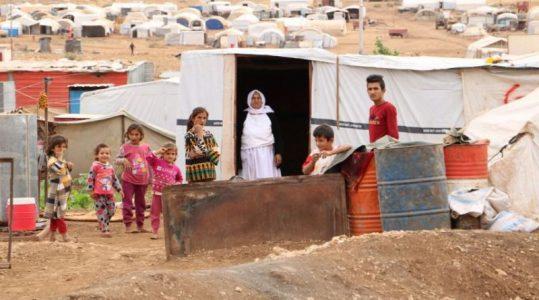
ISIS terrorist group may be gone but Iraq’s Yazidis are still suffering
Iraq’s strategically located town of Sinjar, now empty of civilians and devoid of life, lies buried beneath rubble. Although it was liberated from the Islamic State three years ago, the city remains in ruins—and has become rife with proxy militias vying for regional control.
Situated about 20 miles from the Syrian border, the town lies south of the Sinjar Mountains, a range that has always held geographic importance. Former Iraqi dictator Saddam Hussein reportedly used the mountains, which have a high point of 4,800 feet, to launch missiles into Israel during the Gulf War in the 1990s.
In recent years, Sinjar, home to the Yazidis, an ethno-religious minority, was the site of an Islamic State-led genocidal campaign. On Aug. 3, 2014, the terrorist group mercilessly attacked the town, slaughtering thousands of civilians and abducting women and girls who were then taken to Syria and sold or given as sex slaves to Islamic State fighters. Those who could make it sought refuge atop Sinjar’s rugged mountains. While under the jihadi group’s control, Sinjar provided a land corridor and supply route linking Islamic State strongholds in Syria and Iraq.
Since Sinjar’s liberation in late 2015, a slew of militias have poured in, creating a leadership vacuum that threatens the region’s stability.
“Despite having been freed from ISIS presence … the region de facto remains an occupied district where competing Iraqi and foreign agendas play out by coopting Yazidis into rival armed groups,” Maria Fantappie, the senior advisor on Iraq at the International Crisis Group, told Foreign Policy. The continued presence of groups in the area is preventing reconstruction, demining, and the safe return of Yazidis to their homes, she added.
Four factions currently occupy Sinjar and its surrounding areas, none of which has full control: Iraqi government forces, the predominantly Syrian Kurdish People’s Protection Units; the Popular Mobilization Units (PMU), an Iraqi government-sanctioned paramilitary force backed by Iran; and the Ezidxan Protection Force, a local Yazidi militia of 3,000 troops. Flags change at each checkpoint in and around the town as each party attempts to assert dominance.
Distrust is endemic, especially toward the Iranian-backed militia. “There is no security in Sinjar; it’s not safe because of the (PMU),” said Edo Hayder Murad, deputy commander of the Yazidi Ezidxan forces in Sinjar town. “They want to use this area to control the top of the mountain, they want to control Israel, they want to control everything,” he said, referring to Saddam’s use of the mountain to fire missiles at Israel during the Gulf War.
He’s calling on the international community to create an armed force based in Sinjar to protect the Yazidis. But talks with the Americans and Europeans have so far yielded few results. Cmdr. Murad even requested a one-on-one meeting with U.S. President Donald Trump but says he’s yet to receive a response. He worries if the predominantly Shiite PMU takes over, his people will be even worse off than under the Islamic State.
According to a report by the International Crisis Group published in February, there’s reason to worry. Since October 2017, the PMU has had the political and military upper hand in Sinjar and is providing a corridor for Iran to gain access to Syria.
Meanwhile, thousands of Yazidis who fled their homes four years ago remain wary and unconvinced, as painful memories of being abandoned and left to die by the Iraqi and Iraqi Kurdish Peshmerga forces when the Islamic State attacked, remains singed in their minds.
More than 3,000 people are still sheltering on the side of the picturesque mountain range, preferring to brace for another cold winter in tattered tents than return to their homes. On a visit to Sinjar in October, more than a dozen Yazidis said they don’t trust any of the armed groups at the base of the mountain.
“If they don’t bring us an international force we won’t go back,” said Baraket Hudeda Castle. The 38-year-old Yazidi, a former officer in the Iraqi Army, was once a captive of the Islamic State and has been living on the mountainside since his family paid the jihadi group $60,000 for his release in the summer of 2014. “They told me they were going to cut off my head and mail it to my relatives,” he said, cringing as he recounted the month he spent as a captive in Syria.
Herto Hamrash Minut, 74, was kidnapped by Islamic State fighters in his village near Sinjar four years ago and held for more than eight months. “They’d starve us; it was like living in hell,” he said, hanging his head. Crouched outside his tent on the mountain surrounded by his two wives and 12 children, the frail old man traced his fingers over his ears. He lost most of his hearing during his time in captivity when his captors would hit him over the head. Minut’s family has been living on the mountain for more than a year with no plans to leave; they don’t even know who is responsible for their safety.
Most Yazidis on the mountain are pinning their hopes for a new future on one of their own. This year’s Nobel Peace Prize co-winner, Nadia Murad, is from Sinjar district, and was recognized for her efforts to end sexual violence as a weapon of war.
Source: Foreign Policy





